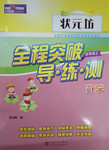题目内容
It is generally believed that communication skills are becoming ______ it takes to be a good doctor.
A. whether B. that C. how D. What
练习册系列答案
 状元坊全程突破导练测系列答案
状元坊全程突破导练测系列答案
相关题目
题目内容
It is generally believed that communication skills are becoming ______ it takes to be a good doctor.
A. whether B. that C. how D. What
 状元坊全程突破导练测系列答案
状元坊全程突破导练测系列答案